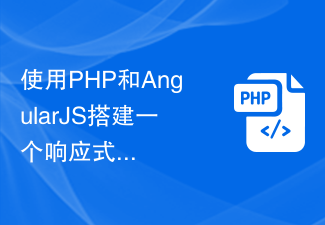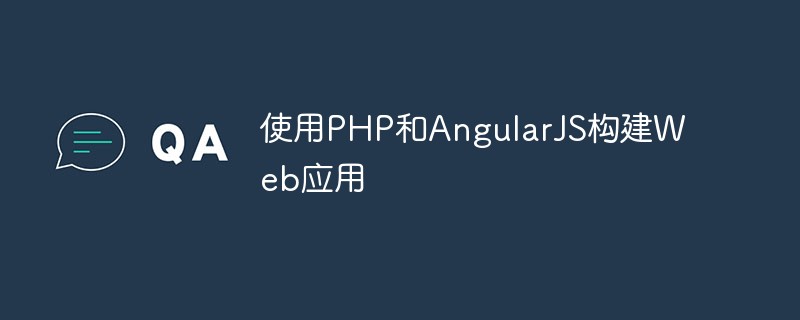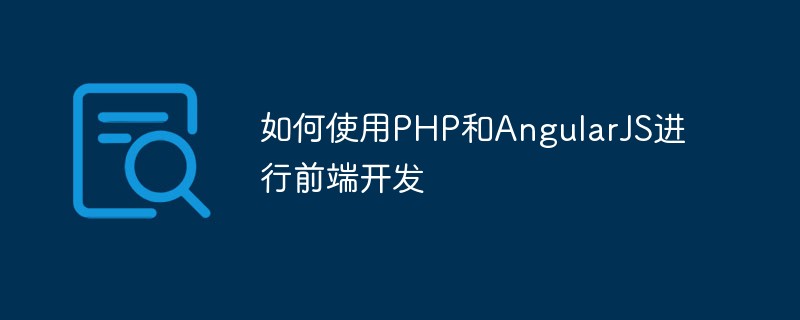 Web Front-end
Web Front-end JS Tutorial
JS Tutorial Teach you how to use the AngularJS framework to achieve control verification effects with one line of JS code_AngularJS
Teach you how to use the AngularJS framework to achieve control verification effects with one line of JS code_AngularJS
As shown in the picture above, we need to implement the following verification functions:
Controls are all must-lose controls
Both need to control the maximum length
When opening the page for the first time, the control cannot be displayed in an error state
After the input content is cleared, the required input control needs to be displayed in an error state
Only when all inputs are legal can the publish button become available
Through AngularJS, we can easily implement these requirements with only 1 line of JS code. The UI style used here is Bootstrap. Let’s start with the sample code:
HTML.
<!DOCTYPE html>
<html lang="zh-cn" ng-app="ftitApp">
<head>
<meta charset="utf-8" />
<title>Demo</title>
<link href="/Content/bootstrap.css" rel="stylesheet"/>
<script src="/Scripts/angular.js"></script>
</head>
<body>
<div class="container body-content">
<!-- 主要内容区域 -->
<div class="row main-content">
<div class="col-md-9">
<!-- 联系我们表单区域 -->
<form action="/Contact/Create" method="post" role="form" name="createContactForm" ng-controller="ContactCreateController">
<!-- UserName 您的称呼 -->
<div class="form-group has-feedback" ng-class="{'has-success' : !createContactForm.UserName.$pristine && createContactForm.UserName.$valid, 'has-error' : !createContactForm.UserName.$pristine && createContactForm.UserName.$invalid }">
<label for="UserName">您的称呼*</label>
<input type="text" class="form-control" ng-model="userName" name="UserName" autofocus="" required ng-maxlength=30>
<div ng-show="!createContactForm.UserName.$pristine && createContactForm.UserName.$valid">
<span class="glyphicon glyphicon-ok form-control-feedback"></span>
</div>
<div ng-show="!createContactForm.UserName.$pristine && createContactForm.UserName.$invalid">
<span class="glyphicon glyphicon-remove form-control-feedback"></span>
</div>
</div>
<!-- UserMail 邮箱地址 -->
<div class="form-group has-feedback" ng-class="{'has-success' : !createContactForm.UserMail.$pristine && createContactForm.UserMail.$valid, 'has-error' : !createContactForm.UserMail.$pristine && createContactForm.UserMail.$invalid }">
<label for="UserMail">邮箱地址*</label>
<input type="email" class="form-control" ng-model="userMail" name="UserMail" required ng-maxlength=30>
<div ng-show="!createContactForm.UserMail.$pristine && createContactForm.UserMail.$valid">
<span class="glyphicon glyphicon-ok form-control-feedback"></span>
</div>
<div ng-show="!createContactForm.UserMail.$pristine && createContactForm.UserMail.$invalid">
<span class="glyphicon glyphicon-remove form-control-feedback"></span>
</div>
</div>
<!-- Subject 主题 -->
<div class="form-group has-feedback" ng-class="{'has-success' : !createContactForm.Subject.$pristine && createContactForm.Subject.$valid, 'has-error' : !createContactForm.Subject.$pristine && createContactForm.Subject.$invalid }">
<label for="Subject">主题*</label>
<input type="text" class="form-control" ng-model="subject" name="Subject" required ng-maxlength=100>
<div ng-show="!createContactForm.Subject.$pristine && createContactForm.Subject.$valid">
<span class="glyphicon glyphicon-ok form-control-feedback"></span>
</div>
<div ng-show="!createContactForm.Subject.$pristine && createContactForm.Subject.$invalid">
<span class="glyphicon glyphicon-remove form-control-feedback"></span>
</div>
</div>
<!-- Content 内容 -->
<div class="form-group has-feedback" ng-class="{'has-success' : !createContactForm.Content.$pristine && createContactForm.Content.$valid, 'has-error' : !createContactForm.Content.$pristine && createContactForm.Content.$invalid }">
<label for="Content">内容*</label>
<textarea cols="4" rows="5" class="form-control" ng-model="content" name="Content" required ng-maxlength=1000></textarea>
<div ng-show="!createContactForm.Content.$pristine && createContactForm.Content.$valid">
<span class="glyphicon glyphicon-ok form-control-feedback"></span>
</div>
<div ng-show="!createContactForm.Content.$pristine && createContactForm.Content.$invalid">
<span class="glyphicon glyphicon-remove form-control-feedback"></span>
</div>
</div>
<!-- 提交按钮 -->
<div class="form-group">
<div ng-show="createContactForm.$valid">
<input type="image" src="/Content/images/comment_publish_button.png" onsubmit="submit();" value="发布" ng-disabled='!createContactForm.$valid' />
</div>
<div ng-show="!createContactForm.$valid">
<img src="/static/imghwm/default1.png" data-src="/Content/images/invalid_publish_button.png" class="lazy" / alt="Teach you how to use the AngularJS framework to achieve control verification effects with one line of JS code_AngularJS" >
</div>
</div>
</form>
</div>
</div>
</div>
<script src="/Scripts/ftit/ContactCreateController.js"></script>
</body>
</html>
JS code (really only one line)
ContractCreateController.js
var ftitAppModule = angular.module('ftitApp', []);
That’s it. Let’s explain a few key points:
ng-class: This tag is used to control the value of class. For example, ng-class="{'has-success' : !createContactForm.Content.$pristine} means that if the value of !createContactForm.Content.$pristine is true, the value of class is has-success.
ng-show: Controls whether to display the control.
createContactForm.$valid: After all verifications are passed, the value is true, otherwise it is false
createContactForm.Content.$valid: Identifies whether the Content control passes verification, if passed it is true, otherwise it is false
createContactForm.Content.$pristine: identifies whether the Content control has never been entered. True if never entered, false otherwise
For more detailed technical issues, please check the AngularJS technical documentation.
 2022年最新5款的angularjs教程从入门到精通Jun 15, 2017 pm 05:50 PM
2022年最新5款的angularjs教程从入门到精通Jun 15, 2017 pm 05:50 PMJavascript 是一个非常有个性的语言. 无论是从代码的组织, 还是代码的编程范式, 还是面向对象理论都独具一格. 而很早就在争论的Javascript 是不是面向对象语言这个问题, 显然已有答案. 但是, 即使 Javascript 叱咤风云二十年, 如果想要看懂 jQuery, Angularjs, 甚至是 React 等流行框架, 观看《黑马云课堂JavaScript 高级框架设计视频教程》就对了。
 使用PHP和AngularJS搭建一个响应式网站,提供优质的用户体验Jun 27, 2023 pm 07:37 PM
使用PHP和AngularJS搭建一个响应式网站,提供优质的用户体验Jun 27, 2023 pm 07:37 PM在如今信息时代,网站已经成为人们获取信息和交流的重要工具。一个响应式的网站能够适应各种设备,为用户提供优质的体验,成为了现代网站开发的热点。本篇文章将介绍如何使用PHP和AngularJS搭建一个响应式网站,从而提供优质的用户体验。PHP介绍PHP是一种开源的服务器端编程语言,非常适用于Web开发。PHP具有很多优点,如易于学习、跨平台、丰富的工具库、开发效
 使用PHP和AngularJS构建Web应用May 27, 2023 pm 08:10 PM
使用PHP和AngularJS构建Web应用May 27, 2023 pm 08:10 PM随着互联网的不断发展,Web应用已成为企业信息化建设的重要组成部分,也是现代化工作的必要手段。为了使Web应用能够便于开发、维护和扩展,开发人员需要选择适合自己开发需求的技术框架和编程语言。PHP和AngularJS是两种非常流行的Web开发技术,它们分别是服务器端和客户端的解决方案,通过结合使用可以大大提高Web应用的开发效率和使用体验。PHP的优势PHP
 使用PHP和AngularJS开发一个在线文件管理平台,方便文件管理Jun 27, 2023 pm 01:34 PM
使用PHP和AngularJS开发一个在线文件管理平台,方便文件管理Jun 27, 2023 pm 01:34 PM随着互联网的普及,越来越多的人在使用网络进行文件传输和共享。然而,由于各种原因,使用传统的FTP等方式进行文件管理无法满足现代用户的需求。因此,建立一个易用、高效、安全的在线文件管理平台已成为了一种趋势。本文介绍的在线文件管理平台,基于PHP和AngularJS,能够方便地进行文件上传、下载、编辑、删除等操作,并且提供了一系列强大的功能,例如文件共享、搜索、
 如何使用PHP和AngularJS进行前端开发May 11, 2023 pm 05:18 PM
如何使用PHP和AngularJS进行前端开发May 11, 2023 pm 05:18 PM随着互联网的普及和发展,前端开发已变得越来越重要。作为前端开发人员,我们需要了解并掌握各种开发工具和技术。其中,PHP和AngularJS是两种非常有用和流行的工具。在本文中,我们将介绍如何使用这两种工具进行前端开发。一、PHP介绍PHP是一种流行的开源服务器端脚本语言,它适用于Web开发,可以在Web服务器和各种操作系统上运行。PHP的优点是简单、快速、便
 如何在PHP编程中使用AngularJS?Jun 12, 2023 am 09:40 AM
如何在PHP编程中使用AngularJS?Jun 12, 2023 am 09:40 AM随着Web应用程序的普及,前端框架AngularJS变得越来越受欢迎。AngularJS是一个由Google开发的JavaScript框架,它可以帮助你构建具有动态Web应用程序功能的Web应用程序。另一方面,对于后端编程,PHP是非常受欢迎的编程语言。如果您正在使用PHP进行服务器端编程,那么结合AngularJS使用PHP将可以为您的网站带来更多的动态效
 使用Flask和AngularJS构建单页Web应用程序Jun 17, 2023 am 08:49 AM
使用Flask和AngularJS构建单页Web应用程序Jun 17, 2023 am 08:49 AM随着Web技术的飞速发展,单页Web应用程序(SinglePageApplication,SPA)已经成为一种越来越流行的Web应用程序模型。相比于传统的多页Web应用程序,SPA的最大优势在于用户感受更加流畅,同时服务器端的计算压力也大幅减少。在本文中,我们将介绍如何使用Flask和AngularJS构建一个简单的SPA。Flask是一款轻量级的Py


Hot AI Tools

Undresser.AI Undress
AI-powered app for creating realistic nude photos

AI Clothes Remover
Online AI tool for removing clothes from photos.

Undress AI Tool
Undress images for free

Clothoff.io
AI clothes remover

AI Hentai Generator
Generate AI Hentai for free.

Hot Article

Hot Tools

SublimeText3 Chinese version
Chinese version, very easy to use

Dreamweaver Mac version
Visual web development tools

WebStorm Mac version
Useful JavaScript development tools

Notepad++7.3.1
Easy-to-use and free code editor

SecLists
SecLists is the ultimate security tester's companion. It is a collection of various types of lists that are frequently used during security assessments, all in one place. SecLists helps make security testing more efficient and productive by conveniently providing all the lists a security tester might need. List types include usernames, passwords, URLs, fuzzing payloads, sensitive data patterns, web shells, and more. The tester can simply pull this repository onto a new test machine and he will have access to every type of list he needs.






